Borago officinalis



Soft wooded
No secondary (woody) tissue being formed. The texture is fleshy and is soft, easy to cut.
Low Bun Shape
A plant forming a low mound, rounded shape.This upright annual herb forms a rounded bushy habit with prickly hairy stems. It has dull dark green oval-shaped leaves and the bright blue pendant star-shaped flowers appear in clusters from spring to early summer.
Borago officinalis L. is an old herb that is naturally found in Europe growing in most well drained moderately fertile soils. It prefers an open sunny to semi shaded position and is drought tolerant but frost tender.
Borage is an easy to grow annual herb that is planted in garden beds or containers for cottage and herb gardens. It can be grown in the mountains or on the coast establishing from seed in one season and has culinary uses with a cucumber taste and is commonly used in salads. It has herbal use and has long been used in herbal remedies for kidney and bladder ailments, sore throats and to reduce fever. Once established it has a medium water requirement, (Scale: 2-drops from 3) and responds to mulching with an occasional deep watering during dry periods.
Borago (bo-RAH-go) officinalis (o-fi-ki-NAH-lis)
Note:
In Australia Borago officinalis is commonly found growing on roadsides or in disturbed soils and may be classed as a weed.
Boraginaceae (BOR-ah-jin-AY-see-ee)
This family consists of plants that are decorative, medicinal and used for dies.
Distribution
It is found throughout the world in temperate to sub-tropical climates. There are many species in the Mediterranean areas in Europe.
Diagnostic features
These plants may be herbs, shrubs and trees, commonly covered in rough hairs.
The leaves are arranged alternate and are a simple shape with no stipules.
The flowers are arranged in helicoid cymes and progressively uncoil then bloom. They are bisexual and may be regular in shape with five sepals that may or may not be fused at the base. The fused petals form a campanulate to salverform shape that has scales at the base or mouth of the corolla.
The five stamens are arranged alternately with the corolla lobes and may be of different length or with appendages at the base.
The ovary is superior consists of two fused carpels with a false wall that divides it into four and then produces four dry nutlets. Each chamber has one ovule and the style is terminal. The fruit is a schizocarp and normally splits into four 1 seeded mericarps that are rugose, spiny or glabrous.
The seed may have an endosperm and the embryo is curved.
Note:
Pollinated by insects these plants are successful and in many areas become weeds with a carpet of flowers. There are about 100 genera and 2,000 species that are found in temperate or tropical areas.
This plant tolerates between USDA zones 5a to 10a and grows to 0.6 m (30 in)
Fahrenheit -20º to 35º F
These temperatures represent the lowest average.
Celsius -28.8º to 1.6º C

Attention
The information displayed on this plant is based on research conducted in our horticultural library and from reliable online resources. We also make observations of the plant that we photograph, and all care is taken to ensure the details are correct.
All photographs and data are covered by copyright. Apart from any fair dealing for the purpose of private study, research, reference or review, as permitted under the Copyright Act, no part including images and text may be reproduced by any means without written permission. The information presented in the map is only indicative and may contain errors and omissions. All inquiries should be addressed to sales@plantfile.com attention Peter Kirkland.

Simple
The leaf that is not divided.
Oval
A leaf that forms an oval shape.
Basal
When the leaves grow from the base of the plant or radically from the root-shoot point.
Sinuate
A leaf margin that is equally concave and convex.
Stellate
When the petals radiate from a common centre forming a star-shape.
Cyme
Flowers that are both solitary and branching into solitary.| Jan | Feb | Mar | Apr | May | Jun |
| Jul | Aug | Sep | Oct | Nov | Dec |
The pendant 5 pettaled stellate flowers are arranged on a terminal leafy cyme that is held above the foliage. The flower throats have scales and stamens that form a cone-shape and the flower is also editable. They appear from late spring to early summer.

Nut (dim. nutlet)
An indehiscent single locular 1 to 2 seeded fruit. Outer layer (pericarp) has a hard layer."Borage is an easy to grow annual herb that is planted in garden beds or containers for cottage and herb gardens. It can be grown in the mountains or on the coast establishing from seed in one season and has culinary uses with a cucumber taste and is commonly used in salads. It has herbal use and has long been used in herbal remedies for kidney and bladder ailments, sore throats and to reduce fever.
Sow fresh seeds in situ during spring.
Divide established clumps during spring.
Take cuttings from summer to autumn and in cold climates place in a cold frame till spring.
Propagation by seed (General)
Germination
In order for a seed to germinate it must fulfil three conditions.
1. The embryo must be alive (a viable seed).
2. The seed must have no dormancy-inducing physiological, physical or chemical barrier to germination; also the seed must be nondormant.
3. The seed must have the appropriate environmental requirements, water, temperature and oxygen.
The interaction between these requirements and dormancy is complex and may lead to different environmental requirements that avoid the dormancy of a seed.
Sowing seeds in containers
There are two general methods for germinating seeds.
Sow seeds in a flat or germinating bed, through which seedlings are pricked-out then, transplanted into another flat with wider spacing or directly to an individual pot.
2. Sowing seeds by placing them in to flats with the appropriate spacing or into individual pots.
This method is normally carried out with medium to large seeds such as woody plants and plants that are difficult to transplant.
Seedling production normally occurs in a greenhouse / glasshouse, cold frames and on hot beds.
Method of seed sowing
Fine seed is sown in pots or flats that are no deeper than 70 to 80 mm (3 1/8 in). using a sterilised well-drained media (soil). Fill the container to 20 mm (¾ in) from the top and sprinkle sieved peat to 3 mm (1/10 in) depth. Press the media down level and firm with a piece of timber and then thoroughly moisten.
Mix the fine seed with washed sand and then sow thinly on the surface. These may be lightly covered with sand.
Larger seeds may be covered with media or a hole is dibbled and the seed is placed in the media.
Watering methods
For watering you may either mist the containers from above or place the container in tepid water and allow the water to raise through the pot to the surface of the media, then drain away and do not fill to the top of the container.
Place a piece of glass over the pot and store in a protected warm environment (glasshouse).
Seeds germinate best in darkness so shade the containers if in direct sunlight.
After the seedlings have sprouted remove the glass and ease the seedlings into direct light.
When the seedlings are large enough prick them out and transplant into larger containers then place them in a shade house to harden off.
Many seeds have different methods of seed preparation for germination such as nicking or cutting the seed coat to allow water penetration, also placing seeds in hot water and allowing it to cool off.
This is particularly important as it is softening the seed coat.
Asexual propagation (Cuttings general)
Propagation from cuttings is possible because every cell of a plant containers the genetic information to create an entire plant.
1. Reproduction occurs through the formation of adventitious roots and shoots.
2. The uniting of vegetative parts with budding and grafting.
3. Taking stem cuttings and layering is possible due to the development of adventitious roots
4. Root cuttings can form new shoots then it is possible to join roots and shoots to form a new plant.
5. A new plant may be formed from a single cell in an aseptic culture system, (cloning).
It is important to propagate vegetatively as this form of cloning retains the unique characteristics of the cultivars or where particular aspects of a plant may be lost if propagated by seed.
Equipment required for taking cuttings
1. A sharp knife that is not too large or a razor mounted in a handle.
2. Good pair of sharp secateurs that is clean.
3. A dibbler to make a hole in the media and allow the cutting to be placed in.
4. Propagation structures that are either a timber frame with glass or polyethylene cover or a glasshouse.
The object of the structure is to create an environment where the temperature and humidity can be controlled. This can be achieved with a simple cover over a pot with a wire frame and plastic.
This stops the draughts and maintains humidity.
5. A hotbed is a useful item as many plants root more quickly if the media is slightly warmer.
Bottom heat is obtained from thermostatically controlled heating cables that are running under the media.
6. Misting systems are of great benefit to cuttings as the regulated fogging with water inhibits the cuttings from drying out and as a result the cuttings may be grown in full sun.
This results in faster root development that is less subject to diseases by fungi and bacteria.
7. Rooting mediums
The rooting medium must be well drained, sand may be used as long as it is thoroughly washed and leached of all salts. It is very well drained and it is excellent for cutting that root up quickly. Equal parts of sand and peat moss have good results for cuttings, which are left for a period of time to allow the roots to form.
Vermiculite and perlite are also used as a well-drained rooting media but has the same disadvantage as sand having no nutrients. The cuttings must be potted up as soon as the roots developed, or a light application of liquid fertiliser can be applied.
Types of cuttings
Stem cuttings
These are the main types of cuttings.
1. Softwood cuttings
These cuttings are taken from young growth on side shoots and tip growth.
2. Semi hardwood cuttings
These cuttings are taken from wood that is firmer and semi ripe usually during mid summer.
3. Hardwood cuttings
These cuttings are taken from mature wood normally towards the end of the season.
4. Root cuttings
Cut sections of roots to obtain new plants during late winter to early spring.
5. Leaf cuttings
Cut the leaf blade in order to obtain new plants during the growing period of the plant.
Cutting preparation
Hardwood cuttings
When taking hardwood cuttings remove the leaves and in semi hardwood reduce the number of leaves by half. Cut the wood straight across just below a node or joint. Hardwood cuttings are normally between 100 to 760 mm (30 in) long and may have either a heel of the older wood attached to the base, or a short section of the older wood at the base. These cuttings are prepared during the dormant season from late autumn to early spring and are made up from previous season's growth.
This type of cutting is used for woody deciduous plants such as Crepe Myrtle, Rose rootstocks and some fruit trees.
The cuttings should be healthy wood with ample supply of stored food as to nourish developing roots, shoots and placed in the rooting media with the aid of a dibbler stick.
Softwood cuttings
The cuttings for softwood should be 60 to 130 mm (5 1/8 in) long and be of material with enough substance as to not deteriorate before the new roots appear. Cut below a node and retain the leaves on the upper portion. Place in a well-drained media and maintain a high humidity.
Soaking the cuttings and leaving them standing in water for long periods is undesirable.
Herbaceous cuttings
These cuttings are taken from succulent plants such as Geraniums and Coleus. The cutting should be 70 to 130 mm (5 1/8 in) long with leaves retained on the upper end. As in softwood cuttings these require an environment of high humidity. Some fleshy cuttings ooze sap and may require a drying period for a few hours before being placed in the rooting media.
Leaf cutting
In these cuttings a leaf blade and petiole or part off is used to raise a new plant. The original leaf doses not become a part of the new plant as roots and shoots appear from the base of the leaf. In some cases roots appear from the severed veins.
Leaf-Bud cuttings
These cuttings incorporate a leaf, petiole and a small piece of the stem. These cuttings are an advantage where the plant uses the axillary bud at the base of the petiole for new shoot growth and maximises available propagation material, as each node will produce a new plant.
As in softwood cuttings these require an environment with high humidity and warmth.
Root cuttings
These cuttings are best taken from younger plants during late winter to early spring prior the new season's growth unless the dormant period is during summer.
Trim the roots as they are dug up, to maintain polarity cut strength at the crown end and a slanted cut at the distal end (away from the crown).
Root cuttings of small plants are placed in flats in lengths of 20 to 50 mm (2 in) and laying horizontally on the surface of the soil. These may be lightly covered with sieved sand or media, watered and then placing a piece of glass or polyethylene over the container till roots / shoots appear.
Fleshy root cuttings
These cuttings should be 50 to 75 mm (3 in) long and placed vertically in a well-drained sand media.
Keep the polarity correct and when the roots develop transplant the cuttings into a separate container.
Large root cuttings
These cuttings are 50 to 150 mm (6 in) long are tied up in bundles and placed in boxes of damp sand, sawdust or peat for about three weeks at a temperature of 4.5º C. When taken out they should be planted in a prepared bed 50 to 80 mm (3 1/8 in) apart with the tops of the cuttings level with or just below the soil level.
Crown division
The crown is the part of the plant at the surface of the soil where new shoots arise. With lateral shoots the crown of some plants requires division when they become crowded.
Herbaceous perennials and multi-branched woody shrubs may develop large crowns that need dividing.
It is a simple method of propagation that is used by amateurs and professionals for a small increase in plants.
Plants that flower during spring to summer are divided during autumn and if flowering in summer to autumn they are divided in spring. The crown is dug up then cut with a knife in to sections, which has a shoot and abundant roots then planted or potted up. The crown may also be divided in some species by using a shovel to cut and dig sections out.
DISEASE
NAME
Powdery Mildew
Various Powdery Mildew Species
Description
Powdery mildew covers arrange of fungal infections most with simular characteristics of white powdery areas appearing on the leaves and flowers.
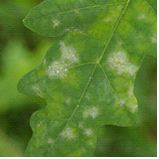
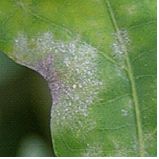 White powdery area
White powdery area
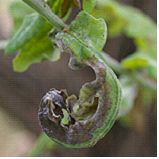
Symptoms
Powdery mildew (Oidium species) affects the following five plant groups with slightly different characteristics.
Cucurbits firstly form white spots on the underside of the leaves. Under optimum conditions the fungus spreads to the upper surface covering the entire leaf causing it to die. It may also extend to the stems slowing the growth of the plant and may reduce the size of the fruit.
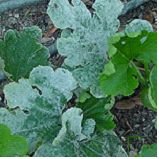
Grape leaves, flowers and fruit are attacked with the appearance of greyish-white powdery spots. Infected flowers set poor quality fruit and infected fruit splits open and dries out.
Pawpaw leaves become infected on the underside at first then spreading covering the entire leaf. The fruit forms irregular light grey spotted areas that damages the surface and under the surface causing the fruit to misshapen and reducing its market value.
Rose leaf and buds are covered in a fine white powdery coating and in severe cases it extends to the stems. When young leaves are infected they become distorted and older leaves develop blackened areas. Infected flower buds may fail to open and opened blooms may be discoloured or distorted.
Strawberries show different signs of infection with the leaf margins first rolling upwards then developing purplish irregular blotches along the veins. The infected flowers may fail to set fruit and if fruit is produced it is small, hard fails to ripen. Semi mature fruit that is infected has dull appearance and may form cracks or split open.
The Powdery Mildew (Sphaerotheca lanestris) infects leaves and twigs. The under side if the leaf firstly has a white mealy growth that matures to felt-like brown mycelium that can cover the entire leaf, and the twig tips. It is only one of the many types that infect Quercus species.
Source and Dispersal
The spores overwinter in fallen leaves, dormant buds, seed and infested plants. It is dispersed by wind.
Favoured Conditions
Generally it prefers warm humid conditions, but failing to germinate when it is raining. The fungus that attacks Pawpaw prefers cooler conditions disappearing in the warmer months.
Affected Plants
There are many plant species ornamental trees and shrubs that are attacked by Oidium species including; Roses, African Violets, Cucurbits, Grapes, Pawpaw, Strawberries, Hydrangeas, Ajugas, Antirrhinum, Oaks and Photinias.
Acer species are infected by the powdery mildews (Uncinula circinata) and (Phyllactinia corylea) but are not normally serious.
Aesculus species are infected by the powdery mildew (Uncinula flexuosa) which forms a white mold on the underside of the leaves.
Arenaria,Cuphea, Erica and Eschscholtzia species are infected by the powdery mildew (Erysiphe polygoni). This fungus is greyish or white and covers leaves or young shoots. Heavenly infected leaves turn brown and fall from the plant. The plant eventually dies.
Aster species are infected with the powdery mildew (Erysiphe cichoracearum) which is more prevalent on the lower part of the plant.
Ceanothus, Corylus, Platanus, Syringa and Weigela species are infected by the powdery mildew (Microsphaera alni) particularly London Plane. The mycelium forms a felt-like cover on the leaves.
Celtis species are susceptible to the powdery mildew (Uncinula parvula) and (Uncinula polychaete). This fungal problem can affect either side of the leaf, which can have spots or be completely coved in mildew. The fruiting bodies appear on the opposite side of the mildew.
Cornus species leaves are infected by the powdery mildew (Microsphaera alni) and (Phyllactinia corylea), covering the leaves in a whitish fungus.
Dahlia species are infected by the powdery mildew (Erysiphe cichoracearum) that forms white powdery areas on the leaf surface.
Lagerstroemia species are infected by the powdery mildew (Uncinula Australiana) that forms white powdery growth on the leaves and may also distort the infected foliage.
Populus and Salix species are infected by a white powdery mildew (Uncinula salicis) that produces black fruiting bodies with a curled tip, but is not normally a major problem.
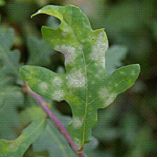
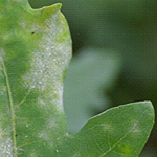 Quercus robur
Quercus robur
Quercus species are susceptible to several powdery mildew fungi including (Sphaerotheca lanestris), (Erysiph trina) and (Phyllactinia corylea). Generally white mealy growth appears on the leaves, normally on the underside turning the infected areas brown and then the leaf dies. The infection may spread to the twig tips causing dieback. Control may be difficult and unwarranted on large trees but nursery stock may be sprayed with a fungicide during susceptible periods.
Rosa species are also infected by the powdery mildew (Sphaerotheca pannosa).
Rudbeckia and Senecio species are covered in white fungus (Erysiphe cichoracearum) which infects leaves, flowers and stems. This results in the plant becoming stunted.
Senecio species are infected by the powdery mildew (Sphaerotheca fuliginea) which forms circular white powdery areas on the leaves.
Spiraea species are infected by the Powdery Mildew (Microsphaera alni) and (Podosphaera oxyacanthae).
Ulmus and Rhododendron (Azalea) species are also infected by (Microsphaera alni). Circular patches of white powdery growth appear on the leaves.
Veronica species are sometimes infected by the powdery mildew (Sphaerotheca humili) causing a white coating to appear on the leaves. Not normally a major problem.

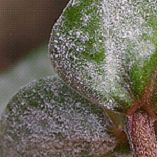
Zinnia elegans are commonly infected by the powdery mildew (Erysiphe cichororacearum), which appears on both sides of the leaves as a greyish powdery cover and may be transmitted by seed.
Non-chemical Control
Choose less susceptible species and when planting space the plants to allow good air circulation. Avoid overwatering and try to keep the foliage dry. Affected plants may be dusted with powdered sulphur or sprayed with a milk mixture to discourage mildew. Vegetables that are infected with mildew should be removed and replaced with new young plants, as they are more resistant to infection.
Chemical Control
Prenatitive spraying during warm humid conditions using a suitable fungicide such as wettable sulphur, bitertanol, carbendazim, fenarimol and triforine helps control the problem.
Note
Always read the label for registration details and direction of use prior to application of any chemicals.
Average Lowest Temperature : -10º C 14º F
USDA : 5, 6, 7, 8, 9,
This USDA (United States Department of Agriculture) hardiness zone chart can be used to indicate a plant’s ability to withstand average minimum temperatures. However, other factors such as soil type, pH, and moisture, drainage, humidity and exposure to sun and wind will also have a direct effect on your plant’s survival. Use this chart only as a guide, always keep the other factors in mind when deciding where, when and what to plant.
A plant's individual USDA zone can be found in the Plant Overview.
Climate Description
Cool to Cold
These zones have low winter temperatures with moderate humidity and moderate summer temperatures.
Frosts and snow are severe. Droughts rarely occur and wind is cold.
Plant growth
Endemic native and exotic cool climate plants grow well within these zones.
| Dictionary | Growth Habit |
| Leaf Type | Botanic Flower Description |
| Leaf Shape | Flower Inflorescence |
| Leaf Arrangement | Fruit Type |
| Leaf Margin | Bark Type |
| Leaf Apex And Bases | Flower Description |